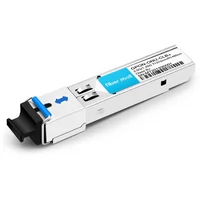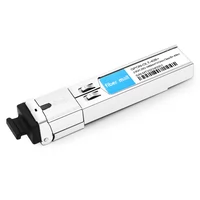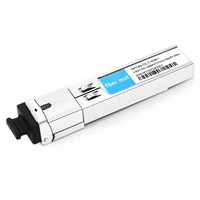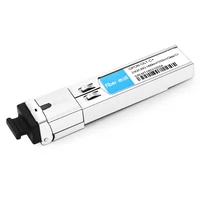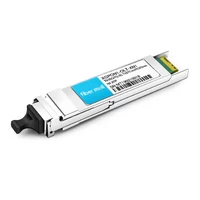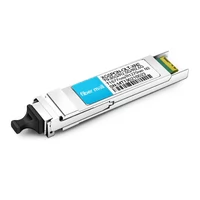On April 23, 2021, the international standard of 50G PON was officially adopted at the general meeting of the 15th research group of the International Telecommunication Union (ITU-T SG15), which indicates that 50G PON has completed the standardization of basic functions. The 50G TDM PON is the new generation PON technology after 10G PON. It is expected that 50G PON will be put into commercial use in 2023.
Table of Contents
ToggleThe history of PON (Passive Optical Network) technology
10G PON is divided into 10G Ethernet PON (EPON) and 10G Gigabit PON (GPON). In 2006, the Institute of Electrical and Electronics Engineers (IEEE) 802.3av began to study and formulate 10G EPON standard. In September 2009, IEEE 802.3av officially released 10G EPON standard. Since 2008, the International Telecommunication Union Telecommunication Standards (ITU-T) started to develop standards for next-generation GPON technologies, namely NG-PON1 and NG-PON2. NG-PON1 usually refers to XG-PON1 (ITU-T G.987), with downlink and uplink rates of 10Gb/s and 2.5Gb/s, respectively. Before NG-PON2 (ITU-T G.989) is commercially available, ITU-T has formulated the XGS-PON standard for symmetric 10G GPON (ITU-T G.9807.1) according to the market demand for symmetric downlink and uplink 10 GB / s rates and the plan for PON technology evolution, the standard was reviewed and approved by ITU-T in June 2016.
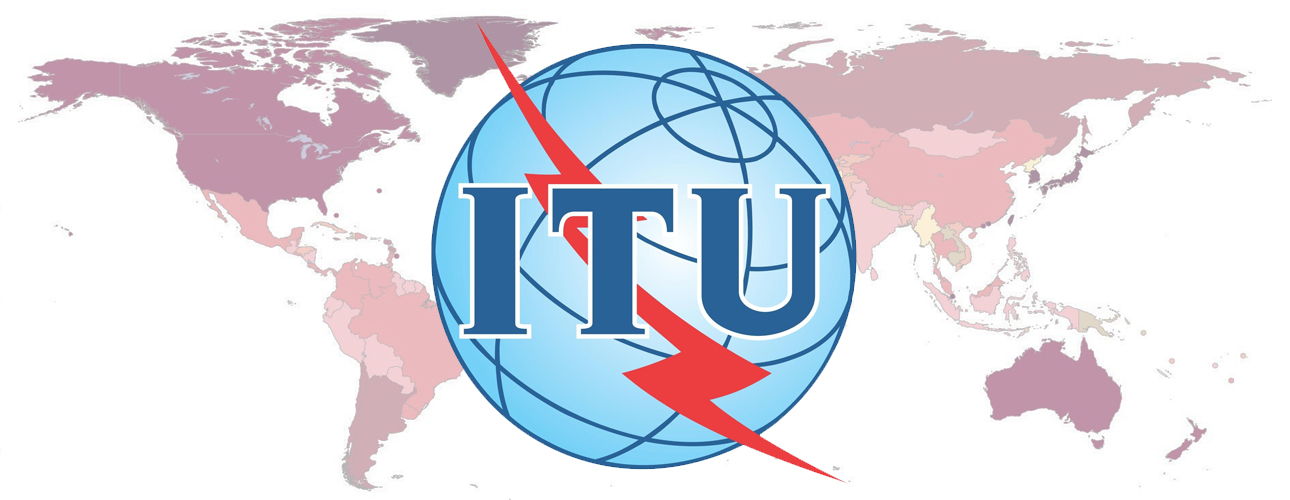
The technology evolution after 10G PON is mainly reflected in the rating upgrade, which can be achieved by supporting 25G/50G or higher rates with a single wavelength, or 40G/80G/100G with multi-wavelength stacking. NG-PON2 adopts a time division and wavelength division multiplexing (TWDM) technology scheme, supporting 4×10Gb/s or more wavelengths stacked with WDM. However, the NG-PON2 standard was not supported by most operators after it was developed, and in addition the optical devices with adjustable multiple wavelengths have not been brought down to a commercially available cost.

At present, the industry chain of 10G PON has matured, mainly in chips, standards and optical modules: in terms of chips, 10G EPON & 10G GPON symmetric/asymmetric SOC chips have been ASIC; equipment manufacturers 8-port, 16-port 0G GPON & 10G EPON single board with scale shipping capability. In terms of standards, ITU’s 10G GPON asymmetric 10G/2.5G started commercialization in 2012; symmetric 10G GPON 10G/10G 2016 standard freeze and commercialization in 2017. IEEE’s symmetric/asymmetric 10G EPON 10G/10G or 10G/1G started commercialization in 2012. In terms of optical modules, 10G EPON symmetric & asymmetric PR/PRX30 is the mainstream shipped product and has been commercialized on a large scale; 10G GPON symmetric & asymmetric N1/N2a/N2 and Combo Class B+/C+ can be shipped on a large scale.
In addition, it is understood that the 50G TDM PON and 10G PON coexistence evolution upgrades are using wavelength division coexistence technology. The capacity of the two generations of PON systems does not affect each other. It supports smooth upgrading by replacing ONU. The implementation methods can be divided into two schemes: MPM dual-mode (built-in wave combining component) and external wave combining.
The core technologies of 50G PON
The next-generation 50G PON will mainly develop in two directions: improving the single-wavelength rate or increasing the total rate through multi-wavelength multiplexing. The industry consensus is that the bandwidth of the next-generation optical access network will be increased to 50Gbps. How to simply and efficiently achieve that bandwidth upgrade has become a hot topic in PON research.
Wavelength Selection
Currently, 50G PON can only use a small portion of wavelengths in the O band, which are not enough. The ITU-T has decided on some wavelengths and is still discussing the other wavelengths.
Line Coding
The ITU-T had considered a number of line coding schemes for 50G PON, including PAM-4, duobinary modulation, and NRZ code. Unlike GPON SFP, the 50G PON ultimately decided to adopt NRZ code that has the highest signal receiving performance, because the PON system requires a very high optical power budget.
Line Rate
The ITU-T has made clear the rate requirement of 50G PON, and supports a combination of symmetric and asymmetric rates, with one downstream rate and four upstream rates available.
FEC
The increase in the line rate of 50G PON reduces receiver sensitivity. To reuse the considerable ODN resources, receiver performance has to be improved. To lower the requirements of the specification for optical components, 50G PON uses the LDPC scheme for FEC.
Common Transmission Convergence
50G PON implements low latencies mainly through DAW, CO-DBA, and shortening the bandwidth allocation interval.
DAW: A DAW can be a wavelength newly defined for 50G PON or one deployed for a PON system preceding 50G PON. It can be an independent upstream wavelength or a pair of upstream and downstream wavelengths. The DAW technology avoids opening a quiet window on the upstream wavelength, thereby eliminating the delay caused by the quiet window.
CO-DBA: The OLT learns about the upstream service transmission requirement of the ONU through the upstream equipment, and then allocates bandwidth to the ONU in advance. This mechanism reduces as much as possible the time for which the service data is cached in the ONU.
Shortening the bandwidth allocation interval: The interval between bandwidth allocations for the ONU is slashed, thus reducing the service data cache time in the ONU. Each T-CONT supports a maximum of 16 burst frames in a 125 us period.
PHY Components
The PHY components of 50G PON mainly include key optoelectronic devices such as optical transmitter modules, optical receiver modules, laser device drivers (LDDs), burst-mode TIAs, and clock-data recovery (CDR) chips. The OLT can use EML or integrated SOA-EML components as the transmitter module, and APD or integrated SOA-PIN components as the receiver module. The ONU differs from the OLT in that the ONU driver needs to support the burst function and that the ONU receiver does not require the burst-mode CDR feature. Experiments and simulations in the industry show that, by using a 50G EML transmitter and an APD receiver, 50G PON can attain a single-wavelength rate of 50Gbps.
There are three coexistence modes of 50G PON and traditional PON, namely:
- 50G PONcoexists with XG (S)

- 50G PONcoexists with 10G EPON

- 50G/ 10G / 1G PON three-generation coexistence

For the application scenario of 50G PON, 5G mobile prequel is mainly added. At the same time, it also adds delay requirements for VR services. The uplink and downlink lines of 50G PON adopt NRZ coding, mainly considering the need to support 32dB optical power budget and higher sensitivity.
In terms of wavelength:

Optical transceiver modules for 50G PON
PON module is a high-performance optical module used in PON system, which uses different wavelengths to send and receive signals between OLT (optical line terminal) and ONT (optical network terminal).
The transmission protocols of PON optical module are APON (ATM PON), BPON (Broadband Passive Optical Network), EPON and GPON, which are widely used at present.
Features of PON optical module:
-Can avoid electromagnetic interference and lightning influence of external equipment
-Reduces line and external equipment failure rate, improves system reliability, and reduces maintenance costs.
The common EPON transceiver in the market today are:
EPON OLT PX20 + / PX20 + + / PX20 + + + and 10G EPON ONU SFP +. These optical modules are applicable to optical network units(ONU) and optical line terminals(OLT). The transmission distance of 10G EPON OLT transceiver is 20km, with single-mode, SC interface and supports DDM.
The common GPON SFP transceiver in the market today are:
GPON OLT Class B +, GPON OLT Class C + , GPON OLT Class C + +. Comparing GPON OLT class B + / C + / C + + optical modules, the main difference lies in the transmission power and reception sensitivity.
Although GPON transceiver has better performance than EPON transceiver, EPON optical module has more advantages in cost. They have their own advantages and disadvantages and can coexist and complement each other.
At present, Avago, MACOM, Oclaro, Renesas and other companies have mature 25G NRZ lasers, which can be used for 25G PON. However, 50G PON transceiver is still in the research and development stage. Some companies have developed optical modules that can be used for 50G PON based on QSFP-DD800 and QSFP112 packaging. Others have developed 50G OLT by WDM and 50G ONU by SFP28 packaging based on CFP2 packaging and dual 25G scheme.
Finally, regarding the 50G PON deployment time forecast, since the deployment time of each generation of PON is about 7-8 years, the deployment of 50G PON is expected to appear around 2023-2025.
Related Products:
-
 GPON-ONU-CLB+ GPON ONU SFP TX-1.25G/RX-2.5G TX-1310nm/RX-1490nm Class B+ 20km SC/UPC SMF DDM Transceiver Modules (Not GPON ONU STICK,NO MAC function)
$15.00
GPON-ONU-CLB+ GPON ONU SFP TX-1.25G/RX-2.5G TX-1310nm/RX-1490nm Class B+ 20km SC/UPC SMF DDM Transceiver Modules (Not GPON ONU STICK,NO MAC function)
$15.00
-
 GPON-OLT-40B+ GPON OLT SFP TX-2.5G/RX-1.25G TX-1490nm/RX-1310nm Class B+ 40km SC SMF DDM Transceiver Modules
$30.00
GPON-OLT-40B+ GPON OLT SFP TX-2.5G/RX-1.25G TX-1490nm/RX-1310nm Class B+ 40km SC SMF DDM Transceiver Modules
$30.00
-
 Calix 100-01836 Compatible GPON OLT SFP TX-2.5G/RX-1.25G TX-1490nm/RX-1310nm Class B+ 40km SC SMF DDM Transceiver Modules
$30.00
Calix 100-01836 Compatible GPON OLT SFP TX-2.5G/RX-1.25G TX-1490nm/RX-1310nm Class B+ 40km SC SMF DDM Transceiver Modules
$30.00
-
 NOKIA 3FE53441BAAA Compatible GPON OLT SFP TX-2.5G/RX-1.25G TX-1490nm/RX-1310nm Class C+ 20km SC SMF DDM Transceiver Modules
$35.00
NOKIA 3FE53441BAAA Compatible GPON OLT SFP TX-2.5G/RX-1.25G TX-1490nm/RX-1310nm Class C+ 20km SC SMF DDM Transceiver Modules
$35.00
-
 XGPON1-OLT-XN1 XG-PON1 OLT XFP TX-9.95G/RX-2.5G TX-1577nm/RX-1270nm N1 SC DDM Optical Transceivers
$237.00
XGPON1-OLT-XN1 XG-PON1 OLT XFP TX-9.95G/RX-2.5G TX-1577nm/RX-1270nm N1 SC DDM Optical Transceivers
$237.00
-
 XGSPON-OLT-XN2 XGSPON OLT XFP TX-9.95G/RX-2.5G/RX-2.5G TX-1577nm/RX-1270nm N2 SC DDM Optical Transceivers
$1095.00
XGSPON-OLT-XN2 XGSPON OLT XFP TX-9.95G/RX-2.5G/RX-2.5G TX-1577nm/RX-1270nm N2 SC DDM Optical Transceivers
$1095.00

